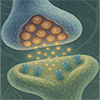| Aug 04, 2025 |
Programmable 2D nanochannels mimic both synaptic behaviour and multiple memory types, marking a major advance in neuromorphic computing.
(Nanowerk News) Researchers at The University of Manchester’s National Graphene Institute have developed a new class of programmable nanofluidic memristors that mimic the memory functions of the human brain, paving the way for next-generation neuromorphic computing.
|
|
In a ground-breaking study published in Nature Communications (“Programmable memristors with two-dimensional nanofluidic channels”), scientists from the National Graphene Institute, Photon Science Institute and the Department of Physics and Astronomy have demonstrated how two-dimensional (2D) nanochannels can be tuned to exhibit all four theoretically predicted types of memristive behaviour, something never before achieved in a single device.
|
|
This study not only reveals new insights into ionic memory mechanisms but also has the potential to enable emerging applications in low-power ionic logic, neuromorphic components, and adaptive chemical sensing.
|
|
Memristors, or memory resistors, are components that adjust their resistance based on past electrical activity, effectively storing a memory of it. While most existing memristors are solid-state devices that rely on electron movement, the team, led by Prof Radha Boya, used confined liquid electrolytes within thin nanochannels made from 2D materials like MoS₂ and hBN. This nanofluidic approach allows for ultra-low energy operation and the ability to emulate biological learning processes.
|
Four memory modes, one device
|
|
The study reveals that by tuning experimental parameters such as electrolyte composition, pH, voltage frequency, and channel geometry, the same nanofluidic device can switch between four distinct memory loop styles, two “crossing” and two “non-crossing” types. These loop styles correspond to different memory mechanisms, including ion-ion interaction, ion-surface charge adsorption/desorption, surface charge inversion, and ion concentration polarisation.
|
|
“This is the first time all four memristor types have been observed in a single device,” said Professor Radha Boya, senior author of the study. “It shows the remarkable tunability of nanofluidic systems and their potential to replicate complex brain-like behaviour.”
|
Mimicking the brain’s synapses
|
|
Beyond demonstrating multiple memory modes, the devices also exhibit both short-term and long-term memory, akin to biological synapses. This dynamic control over memory duration is crucial for developing neuromorphic systems that can adapt and learn from their environment.
|
|
For instance, the devices could “forget” information over time or retain it for days, depending on the applied voltage and electrolyte conditions, e.g., like how one might quickly forget where they left their keys, yet remember their home address for life.
|
|
Imagine you’re working in a café. At first, the clatter of cups and chatter is noticeable, but soon your brain filters it out so you can focus. This everyday phenomenon is called sensory adaptation, and short-term synaptic depression is one of the cellular mechanisms contributing to them. The team mimicked short-term synaptic depression, a process where consecutive neural signals reduce the strength of a response unless sufficient time is allowed for recovery. In neurons, this is caused by temporary depletion of neurotransmitter vesicles. In the nanochannels, a similar effect emerges due to the ionic interactions, which requires time to relax back to its initial state.
|
A minimal model and a major leap
|
|
To explain the observed behaviours, the team developed a minimal theoretical model that incorporates ion–ion interactions, surface adsorption, and channel entrance effects. The model successfully reproduces all four memristive loop types, offering a unified framework for understanding and designing future nanofluidic memory systems.
|
|
“This work represents a major leap in our understanding of ionic memory,” said Dr Abdulghani Ismail, lead author of the study. “It opens up exciting possibilities for low-power, adaptive computing systems that operate more like the human brain.”
|
Towards brain-inspired computing
|
|
By harnessing the unique properties of 2D materials and fluidic ion transport, the researchers envision a new class of reconfigurable, energy-efficient computing devices capable of real-time learning and decision-making, with broad implications for artificial intelligence, robotics, and bioelectronics.
|

